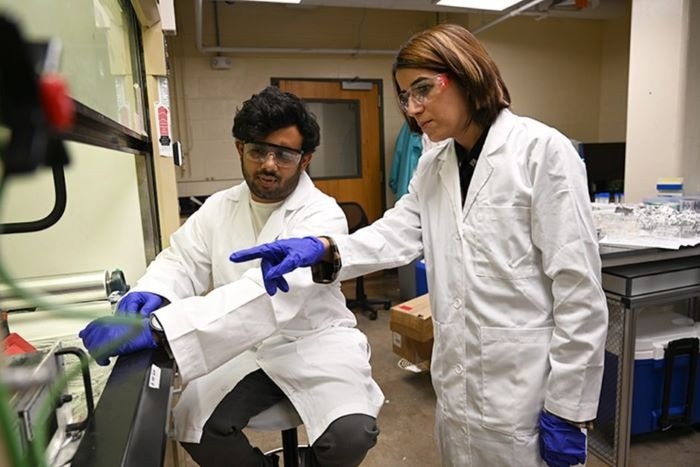Water filters often fail to remove microplastics and can even introduce them, which pose health risks. University of Missouri researcher Maryam Salehi and associates developed a novel method to capture those microscopic intruders and safeguard the general public through the use of a fabric-like filter. The study was published in the Journal of Applied Polymer Science.
 Maryam Salehi and graduate student Anandu Gopakumar Nair investigate filter properties in her lab in Lafferre Hall. Image Credit: University of Missouri
Maryam Salehi and graduate student Anandu Gopakumar Nair investigate filter properties in her lab in Lafferre Hall. Image Credit: University of Missouri
Microplastics have the potential to spread dangerous compounds that lead to numerous health issues, worsen inflammation, and raise the risk of cancer.
The idea is to design a filter that can be attached to a faucet so it can remove microplastic and lead at the same time from tap water. We are envisioning an inexpensive point-of-use filter that could connect to any faucet.
Maryam Salehi, Assistant Professor, Civil and Environmental Engineering, University of Missouri
The filter membrane is composed of polyvinyl alcohol fibers, a polymer commonly used in biomedical applications. The team selected this material due to its affordability and biocompatibility, meaning it is non-toxic to humans, animals, and plants.
It is also shown to be successful. In laboratory experiments, the membrane was able to eliminate over 70% of lead contamination in addition to almost 100% of bigger microplastics and approximately 80% of the tiniest microplastics.
We still need to test the filter to see how it tolerates other conditions such as disinfectant use in water but the idea is to hopefully have something that can be commercialized and used to easily purify tap water.
Maryam Salehi, Assistant Professor, Civil and Environmental Engineering, University of Missouri
Additional authors were Anandu Gopakumar Nair, a Doctoral Student at Mizzou, Alexander Ccanccapa, a Post-Doctoral Researcher, and Kati Bell, an Industry Partner. The study is funded by Brown and Caldwell, as well as the National Science Foundation.
Salehi works as a key researcher at the Missouri Water Center, an organization that advances water research by bringing together stakeholders from government, business, and academia.
Journal Reference:
Nair, G. A., et al. (2024) Development of crosslinked polyvinyl alcohol nanofibrous membrane for microplastic removal from water. Journal of Applied Polymer Science. doi.org/10.1002/app.55428.